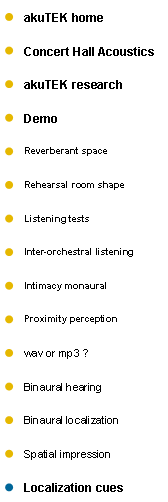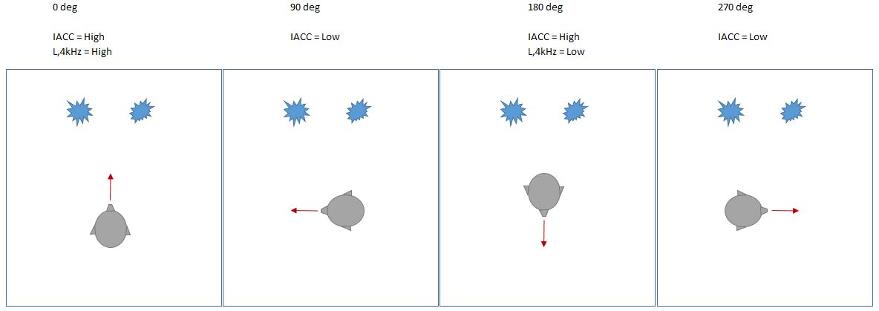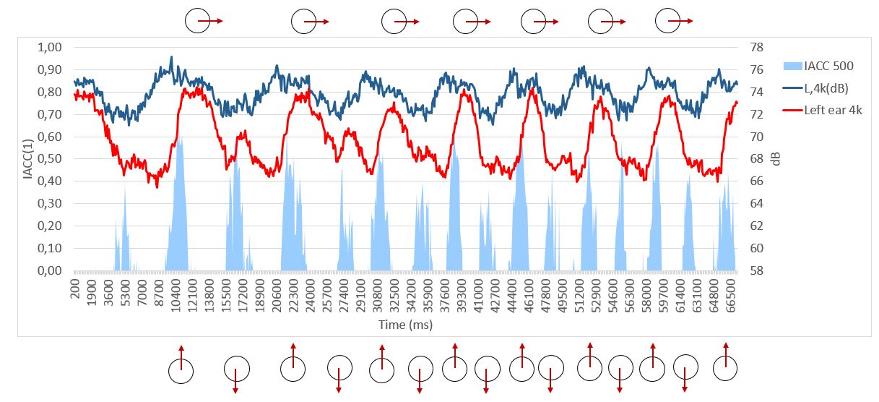



|
akutek.info |
|
The www center for search, research and free sharing in acoustics |
|
Binaural Localization Cues |
|
2016-04-27 Demonstration of cues providing for binaural localization of pink noise sources at time-varying azimuth angle: This article presents an experiment that aims to demonstrate binaural cues available for the brain in order to localize a sound source when azimut angle changes. In this experiment the source is composed by two loudspeakers emitting uncorrelated pink noise, while a person rotates in the azimuth plane, completing 8 rotations in 66 seconds. To listen to the sound at the ears of the rotating person, put on on your headphones and make sure that they reproduce stereo correctly (you may want to perform the headphone test 1-3, below).
Audio demo: Pink noise source at time-varying azimuth angle, link to MP3 (1.1MB)
Inter aural cross-correlation IACC(t) and SPL(t) during the experiment described above was measured with to tiny microphones placed in the outer ear channel. The diagrams will demonstrate that IACC peaks at both 0 degrees and 180 degrees azimuth, an example of the so-called cones of confusion. Sources cannot be localized unambiguously by IACC alone. Explanation of the cones of confusion: Sources at 0 degrees and 180 degrees azimuth happen to produce the exact same Inter-aural time-difference, ITD, in this case ITD=0, at our ears, thus producing equal IACC. Other confused pairs of azimuth angles in the horizontal plane are e.g. 10/170, 55/125 and any angle pairs V and 180-V. Actually, all such angle pairs are intersections between the horizontal plane and concentrical cones centered around the axis through both ears. Two sources located on one and the same cone cannot be discriminated from one another by the cue of ITD or IACC, thus the cones of confusion. Anyway, the ambiguity of the IACC-cue referred to above leads to the question: - How can the brain know whether the source is upfront or behind, assuming the person is blindfolded? In this experiments it turns out that IACC in the 500Hz octave is a better cue than IACC in the1000Hz octave, but not accurate enough to consistently present an unambiguous cue.
Headphone test 1, sound in Left channel only: http://akutek.info/wav/sine440HzLeftonly.mp3 Headphone test 2, sound in Right channel only: http://akutek.info/wav/sine440HzRigthonly.mp3 Headphone test 3, sound image should be centered (adjust L-R balance): http://akutek.info/wav/sine440Hz.mp3
Questions? Just ask by mailto:akutek@akutek.info . |

|
Litterature: Binaural hearing J Blauert: Spatial Hearing: The Psychophysics of Human Sound Localization J Blauert (Editor): The Technology of Binaural Listening J Blauert: Binaural Models and their Technological Application Howard and Angus: Acoustics and Psychoacoustics Fastl and Zwicker: Psychoacoustics. Facts and Models Floyd Toole: Sound Reproduction: The Acoustics and Psychoacoustics of Loudspeakers and Rooms Gilkey and Anderson: Binaural and Spatial Hearing - in real and virtual environments Sue Harding Binaural Processing A Oxenham (Lecture) Binaural hearing Sound localization (wikipedia) R.Y Litovsky: Binaural Hearing (external site) J Breebaart: Sound Binaural processing model based on contralateral inhibition.I. Model structure Misc. Authors: Localization of sound sources (external site) |
|
Figure 1: Experiment setup: A person rotates in a room with two loudspeakers emitting uncorrelated pink noise. The room has approximately V=20 cbm and RT=0.4s |
|
Figure 2: IACC (in 1kHz octave band) peaks at 0 degree and 180 degrees |



|
Figure 3: IACC @500Hz peaks more at 0 degrees than 180 degrees, however not very accurately |

|
Figure 4: The combination of L,4kHz(t) and IACC(t) makes it possible to unambiguously discriminate "upfront" from "behind". IACC @500Hz peaks more at 0 degrees than 180 degrees, however not very accurately |

|
Figure 5: Adding SPL at left ear, 4kHz octave (red curve), to locate source to the left. A difference of 6dB is seen between peaks and valleys, demonstrating the level difference between an ear facing the source and an ear in the shadow of the head, thus the inter-aural level-difference ILD=6dB in the 4kHz octave band in this experiment. Taking both ears into account, the ILD cue appears even stronger, since ILD=SPL,left—SPL,right in this case would vary within +/-6dB, i.e. total 12dB variation . Note: The reverberant environment of a room generally affects the ILD. In anechoic environment the ILD would be bigger than in this experiment. |
|
Published 27.04.2016 Latest change 30.04.2018 |
|
on site |